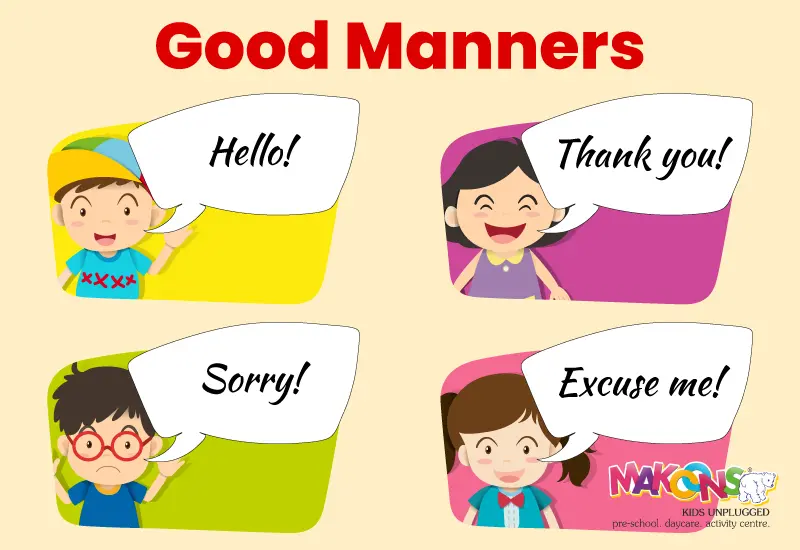Teachers and parents alike want for our kids to grow up to be decent people who could easily manage social situations. Although preschoolers may find early childhood etiquette training, these essential life skills are best developed during these years. Let us learn efficient ways of teaching good manners to nursery children and practical lessons in etiquette for kindergarten that will guide them throughout their lives.
Why Manners Matter for the Littlest Learners
Good nursery manners are more than merely saying “please” and “thank you.” ” Such social skills help kids to pick up respect, empathy, and care for others. Teaching young children etiquette helps them to develop emotional intelligence and social awareness that will benefit them greatly in their early childhood schools and beyond.
Laying the Foundation: Fundamental Manners for Young Children
The process of teaching manners to preschoolers starts with easy, consistent habits.
Teaching young children politeness begins with simple, consistent behaviors:
1. Reflect the behavior you wish to see.
Youngsters learn largely by seeing. toddlers come to see these are natural elements of communication when toddlers see adults in daily contacts utilizing “please,” “thank you,” and “excuse me.” Keep in mind that little eyes are always open—your consistent modeling of good manners is louder than any lesson.
2. Develop frequent practice opportunities
Meal times are great ways to practice etiquette lessons for KG. Easy lessons such as not eating until everybody has been served, using their utensils properly, and requesting politely to leave the table develop a platform of good table etiquette. Practiced daily, it makes kids know that kids’ etiquette and manners are involved in daily normal routine.
3. Reinforce with Positivity
Appreciation is key to making a child understand the importance of good manners. Specific compliments like “I saw how you said ‘thank you’ when Sarah handed you her crayons—that was so polite!” help kids understand the necessity of manners.
Kindergarten Creative Etiquette Course
Toddlers’ learning is more effective when manners are turned into engaging games.
1. Play scenarios from roles.
Children might role-play greetings, please and thank you, waiting their turn, and table etiquette in a pretend restaurant, doctor’s office, or tea party. These entertaining kindergarten etiquette lessons translate abstract ideas into concrete and unforgettable ones.
2.Make use of puppets and storytelling.
Children find great fascination in reading books about manners and puppet shows showing polite versus rude behavior. After reading or viewing, have students talk about the emotions of the characters under both respectful and disrespectful treatment.Easy Interesting 20 Short Story in English With Moral For Kids
3. Create class behavior guidelines.
Simple graphic visual clues remind children of etiquette norms.. One good reminder of class norms is a visual chart showing youngsters greeting, sharing, or coughing and covering their mouths.
Handling Difficult Behaviors with elegance
When teaching children’s etiquette, remember that learning involves mistakes as well.
1. Correct in private when you can
Instead of embarrassing a child in front of classmates, take a moment to talk about behavior that must change in private. A soft, “Remember how we ask for things? Can you repeat that using ‘please’?” works better than public reprimand.
2. Provide alternatives, not corrections
Rather than merely stating “don’t interrupt,” teach words such as “excuse me” and when they can be used. KG etiquette instruction tips must always involve giving children the language and skills they must use to succeed.
3. Pay attention to developmental preparedness.
Some manners concepts are challenging for very young toddlers still developing impulse control.Teaching good behavior for developmentally appropriate expectations and patience calls for kindergarteners.
Beyond Just Thank You and Please Classes in Deeper Manners:
Children’s conception of respect expands as they grow accustomed with basic politeness:
1. Teaching appreciation for diversity
Manners entail treating everyone with respect regardless of differences. Children who follow simple rituals honoring all cultures, skills, and traditions come to develop inclusive views.
2. Body autonomy and consent
Educating children to ask first to hug friends and honor a “no” to touching establishes the foundation of consent. These basic rules of behavior for nursery children foster respect of limits.
3.Technology:
children are already surrounded with it. Simple guidelines on polite volume and no displays sharing digital resources and eating at mealtimes help to show the concept of technological manners.
Partnering with Families
The best manners education occurs when schools and families collaborate:
1. Introduce expectations
Openly communicate properly about the behavior which already taught in the school lessons that will help them value not just in schools but at home also.
2. Respect cultural differences
Many societies view eye contact, greetings, and other facets of manners differently.
Giving families space to discuss their practices completes everyone’s knowledge of good behavior..
3. Celebrate progress
Acknowledge children’s social skill development in parent talks, stressing growth above perfection.
Conclusion
Teaching Kids etiquette is about turning them into nice, polite humans who consider others’ feelings and needs.When we approach kindergarten’s etiquette classes with consistency, inventiveness, and care, give the kids necessary social skills that are useful in future.
Parents and teachers can assist young children acquire a natural awareness of appropriate behavior that will become second nature to them by including these techniques into everyday encounters. Children’s social success and emotional well-being much into the future payoff from the investment we make in teaching manners and etiquette during these early years.
Also Teach kids About – Solar System Names for Kids : Fun Facts About the Planets

